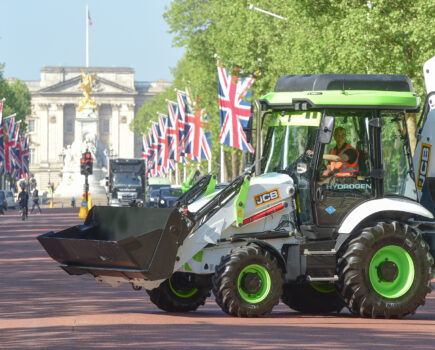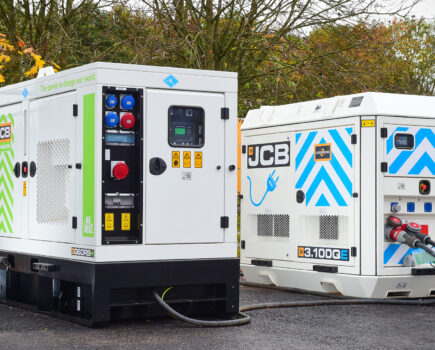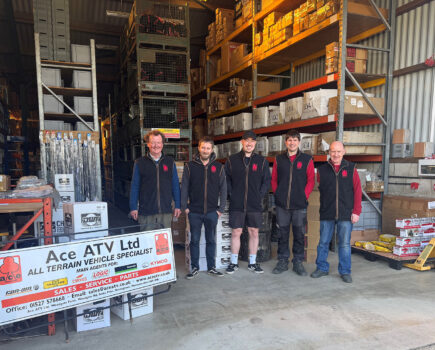As the first pass of a vehicle through a field creates the most compaction through the soil profile beneath its wheel/track paths, any ways in which farmers can minimise the passage of subsequent operations beyond those paths could significantly limit further soil damage – and need not be difficult or costly to achieve.
That was the message from precision farming specialist Ian Beecher-Jones, who outlined some of the measures farmers can take to minimise the risk of soil structure damage, and assess and repair existing issues, at the 2018 Case IH press event held near Dresden, Germany. Small improvements in management practices could have widespread impacts on cost savings, suggested Mr Beecher-Jones, who runs a global precision farming consultancy business, supporting farm equipment owners, dealers and manufacturers with advice on maximising value from precision equipment.
“Soil type is largely irrelevant, with most affected in one way or another, while studies show measurable financial effects on crop establishment costs and yield from reduced traffic and consequent compaction, largely due to the maintenance and preservation of structure.”
Prevention is better than cure
Preventing compaction creation is preferable to and cheaper than alleviating it, said Mr Beecher-Jones.
“To rectify problems and maintain structure, natural and mechanical means can each help. Encouraging earthworm populations and using cover crops are examples of natural aids. Mechanically, auto-steering systems guided by an RTK signal with its 2.5cm repeatable accuracy mean reducing the level of trafficked land within fields need not be a complex process requiring high levels of additional investment.”
Farmers who operate or are considering RTK-based auto-steering systems will already have much of the technology they need to minimise trafficked areas without investing in matched-width implements, he said.
“Full controlled traffic farming (CTF) using exactly the same machine paths without deviation year-after-year may not always be possible everywhere, and ‘managed’ traffic is perhaps a better term for the required approach than ‘controlled’. Consider how factors such as soil type and field slope may affect compaction and the need for correction. Timely use of appropriate, correctly-set implements in the right conditions will help minimise compaction creation, under all types of tillage systems.
Don’t be afraid to be flexible
“Farmers should consider the best way to work a field to minimise traffic – particularly when harvesting and transporting crops. But at other times of the year they shouldn’t be afraid to be flexible to reduce traffic in a practical manner that suits their system best. If, in some years – a wet season or when a non-combinable crop is in the rotation, for example – it’s not possible to exactly follow previous lines, that isn’t the end of the world. Reducing traffic as much as possible over time will still bring about great benefits.”
The same holds true if land must be worked at an angle or has to be ploughed for weed seed burial or soil restructuring, said Mr Beecher-Jones. Such processes might take controlled traffic a step backwards, but if they are necessary for improved agronomy then farmers should not be afraid of that.
“What’s essential is that, whatever the operation, traffic should be minimised at the time. Apart from following the same paths wherever possible, that means considering the impact on those paths. Could tractor tyres with narrower, longer footprints help to spread weight better, and are the ones fitted being operated at the best pressure for the task? Is the tractor weighted properly to minimise wheel slip? Are tracks a better option given the soil type and work circumstances? And is it feasible to alter the track widths of a farm’s tractors so they match as closely as possible? Any marginal gains will ultimately be of benefit.”
Lastly, the harvest process has a significant effect on land throughout the following year, he points out. Studying harvest maps can show any correlation between low yield areas and zones of soil compaction, but harvesting techniques themselves can have a big impact on soil damage ahead of the following crop.
“A complete CTF system isn’t necessary to ensure tractors are positioned carefully during loading. Unloading augers offering extra throw from their end-pieces can help here. And considering tracked front drive units could help to keep the weight of the combine itself within smaller, narrower bands. Lastly, if a combine isn’t due for replacement soon but its working width doesn’t suit a reduced traffic plan, replacing the header alone could be considered as a relatively lower-cost option for those seeking sooner results.”
Case IH CTF solutions: new AccuTurn Pro, pan-country RTK+ coverage, tracked vehicle technology
Hans-Werner Eder, Case IH EMEA product marketing manager, suggested that, when considering investment in technology to minimise compaction, farmers should look carefully at the consistency of coverage provided by signal providers, as well as the provision for any loss of signal, and the ability to link swaths or bouts by way of end-of-row steering automation.
“We are continuing to grow the European-wide Case IH RTK+ network to ensure customers using our AccuGuide auto-steering systems gain from signal coverage that’s as uninterrupted as possible, aided by our xFill technology that bridges gaps in the unlikely event of signal loss,” he explained.
“The RTK+ network currently comprises 979 base stations, providing the consistent coverage necessary for customers in all areas to benefit fully from 2.5cm RTK accuracy and repeatability when aiming to minimise trafficked paths and compaction. As farms grow larger and – in mainland Europe for example – can often cross country borders, few others can provide this spread of uninterrupted pan-European coverage.”
Case IH tractors’ ability to help minimise soil damage is broadened by the introduction for next season of AccuTurn Pro, which brings the benefits of 2.5cm RTK repeatability to headland/end-of-row turning.
“This new development, available on all Case IH tractors with AccuGuide auto-steering using an RTK signal, combines the benefits of HMC II headland management tractor/implement automation with those of RTK-guided auto-steering into the next pass, to limit headland compaction and keep paths on track.”
Mr Eder also urged farmers, when assessing replacement combines and key tractors, to consider whether they are specified with the drive systems that best suit their soils and circumstances.
“The benefits of spreading combine weight over long rather than wide footprints to minimise trafficked area have been shown by the success of tracked Axial-Flow combines, while header widths and unloading auger lengths on all models have been designed to help keep field traffic on track. With the Quadtrac, the merits of a four-track articulated design over a twin-track differentially-steered one have been proven over two decades. The Magnum Rowtrac has shown it’s possible to benefit from tracked traction in a smaller package without resorting to differential steering. And all are available with simple-to-use RTK-guided Case IH AccuGuide for the repeatability necessary to minimise trafficked land and a quick return on investment.”





